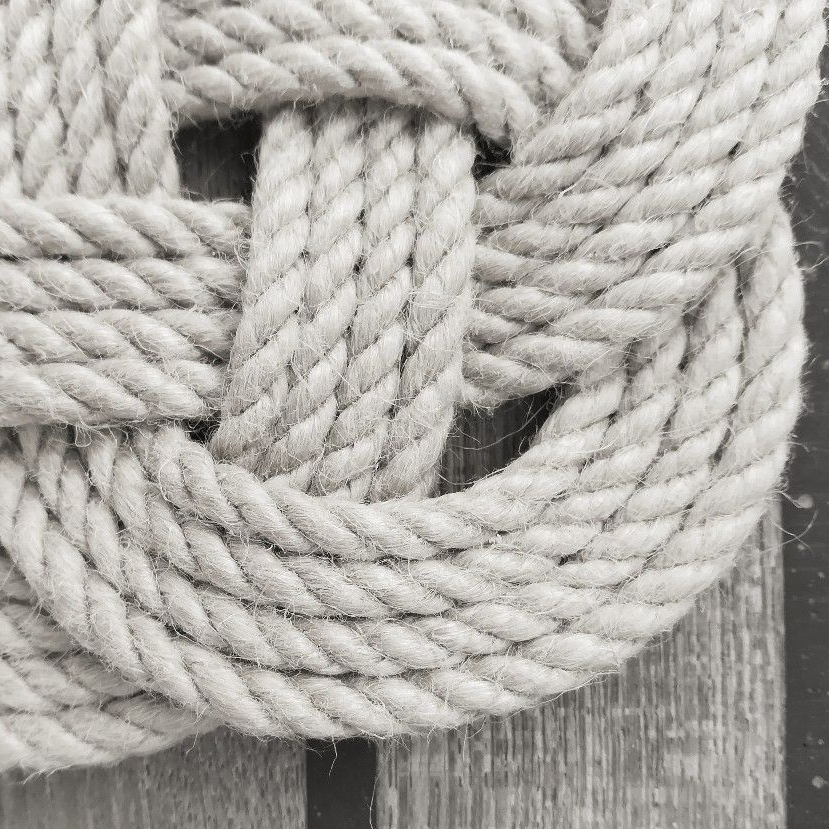The Amazing History Of Rope

Where would we be without rope?
Twisted plant fibres have played a very large part of our history. They were needed to make tools, weapons, and clothing. Without ropes or twines we could not have harnessed animals, pulled a plough, sailed the seas, or explored mountains.
Flax is one of the earliest materials that we humans used to twist into cords and ropes, as well as papyrus reeds, and other plants. Traces of 30,000 year old flax fibres have been discovered embedded in clay.
I bought a reel of flax not long a go, it was heavy for its size, and a most beautiful blonde colour, I realised then why writers described girls with flaxen hair.
Twisting the fibres increases the tensile strength of the individual strands, as they support each other. Firstly a group of strands are twisted left, then three of these are right twisted, which creates a locking effect. Have a look at @fiveinthenest on Instagram, and blog at fiveinthenest.com Jane Haselden posts videos of how to do exactly this with leaves and grasses.
Recently in April 2020, a small fragment of string created from twisted bark fibres was found attached to a Neandertal stone tool in France, it was dated at between 40,000 to 50,000 years old. It is thought to be the oldest woven string to be unearthed. Being plant based it normally rots, unless it is preserved by being in sediment or other anerobic material.
Actual rope knots have been found preserved in European peat bogs and other wet archaeological sites and they are around 10,000 years old. Simple knots such as granny knot, half hitch, clove hitch and reef knot were also found on Neolithic sites. Fishing traps and nets made from twisted flax are amongst some of the oldest items found made from plant fibres in Scandinavia and Switzerland.
In Egypt, papyrus ropes were excavated from a cave recently and were judged to around 4,000 years old, and they looked as well made as a modern line. I doubt the pyramids could have been built without this knowledge. Across the world making rope and twine has been invaluble technology, from sewing clothing, making baskets, bow and arrows, rope bridges.
Exploration by sail must have been the biggest beneficiary of cordage manufacture, from pulling up and trimming sails, to anchoring. Although sailors wouldn't say rope, there is no rope on a boat except the bellrope. As soon as a coil is on board it is named for the job it does, it becomes mooring lines, halyards, and sheets. You can still "learn the ropes" though.
In the days of sail, the most popular fibres for rope were hemp for standing rigging (supports the masts), which was usually preserved with tar, and manila for running rigging (pulling the sails up, and trimming the sails).
My Grandad worked as a rope maker in Derbyshire in the 1930's, and he said it was awful work, but in the Depression, there wasn't a lot of choice. It wasn't well paid , so when his father-in-law told him there was a job going on the railways, he literally ran for it, hurdling over garden fences, which gives you an idea of how much he liked making rope! Working with manila and other natural ropes, would have been very dusty. These ropes were mainly for the cotton mills, and the lead and coal mines nearby.
He was lucky to get out of the business when he did, for a career on the railways, the natural ropes were soon to be replaced by synthetics, such as nylon, polyester, and polyproplene.
Now we have fibres that are as strong as steel, such as kevlar, dyneema, and spectra, I have seen super yachts, with just a simple splice on each shroud. It seems like we are going back to the days of sail style, with their rope standing rigging and deadeyes.
For more about the history and mystery of knots, have a look here.
Having lived and sailed on boats for over 40 years, I am always interested in all things coastal, and nautical. I couldn't imagine living in any other way.
Janette Watson
Falmouth

Comments